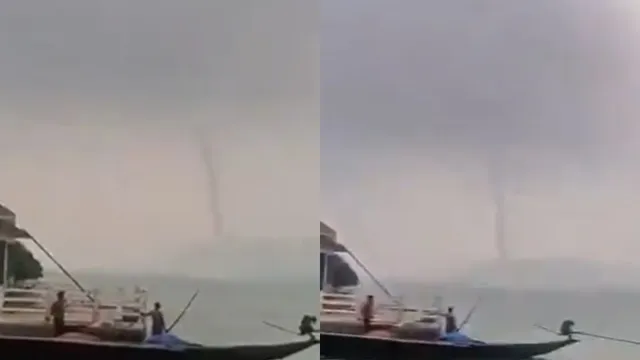- By Chetna Shree
- Sat, 11 Oct 2025 07:42 PM (IST)
- Source:JND
Odisha: A stunning video captured a tornado striking the famous Chilika Lake in Odisha on Friday, sparking a mix of panic and awe among tourists. The tornado appeared southwest of the Kalijai Temple, with hundreds of visitors enjoying the breathtaking view.
Just moments before the tornado faded away, several tourists recorded the breathtaking views on their phones. The videos showcasing the powerful storm have gone viral on social media, taking viewers by surprise.
चिलिका झील में अचानक विशाल बवंडर उठा, लोग इसे देख दहशत में आ गए हैं। यहां देखें वीडियो...#OdishaNews #Chilkalake #BreakingNews pic.twitter.com/4Wr0I95EHR
— Piyush Pandey (@piyush_bebak_) October 11, 2025
Sudden Atmospheric Shift Sparks ‘Haathisundh’ Tornado
A sudden drop in atmospheric pressure triggered the tornado, causing nearby locals and tourists to scream and flee in panic. The brief but intense weather phenomenon, which lasted only a few minutes, has been called Haathisundh (elephant’s trunk).
State Meteorologist Confirms Formation Of Tornado
Speaking to regional media in Odisha, state meteorologist Biswajit Sahoo confirmed that the weather phenomenon was a waterspout, a type of tornado that forms over large water bodies. He further stated that waterspouts typically occur in water bodies around the United States and Canada.
“Their occurrence in India is rare, though a few have been reported in recent years along the Bay of Bengal, particularly in West Bengal. In Odisha, such events are extremely infrequent,” Sahoo said.
Such an event is not unprecedented at the Chilika Lake. Similar occurrences were recorded in 2018 and 2019.
Tornado In India
Though rare in India, tornadoes occasionally occur in eastern and northeastern states like Odisha, West Bengal, Bihar, and Assam, as well as in neighbouring Bangladesh. They usually form during the pre-monsoon months (March to May), when warm, humid air from the Bay of Bengal clashes with cooler, dry air from the north, creating conditions for intensive convective storms that can trigger tornadoes.

